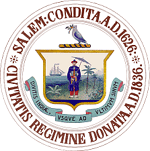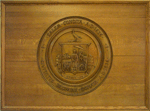City Seal: Difference between revisions
No edit summary |
|||
| (11 intermediate revisions by 2 users not shown) | |||
| Line 1: | Line 1: | ||
The city seal was designed to show the Far East Trade that shaped Salem's commercial history. George Peabody, son of the patriarch of the | The city seal was designed to show the Far East Trade that shaped Salem's commercial history. George Peabody, son of the patriarch of the | ||
pepper merchants, and himself a ship owner, drew a design of a man wearing a flat turban, red trousers and belt, and blue jacket meant to | pepper merchants, and himself a ship owner, drew a design of a man wearing a flat turban, red trousers and belt, and blue jacket meant to | ||
represent the Sumatran men that they traded with for the pepper trade. | represent the Sumatran men that they traded with for the pepper trade. In the center is a full-rigged vessel on the high seas. The palm tree | ||
near the figure would have been an indigenous tree. A dove bearing an olive branch of peace in its mouth represents Salem the city of peace. | |||
Around the circumference, translated from Latin, are the dates of Salem's founding(1626) and incorporation(1836). | |||
The Motto of the city on the seal is: | The Motto of the city on the seal is: | ||
"Divitis Indiae usque ad ultimum sinum" | |||
"''To the Farthest Port of the Rich East''" | "''To the Farthest Port of the Rich East''" | ||
[[Image: | [[Image:cityseal.gif]] | ||
| Line 16: | Line 22: | ||
Vertical File in the Salem Collection - '''Salem City Seal''' | Vertical File in the Salem Collection - '''Salem City Seal''' | ||
[http://evergreen.noblenet.org/eg/opac/record/2382888?locg=63 Essex Institute Historical Collections] Vol. 7, p. | |||
[http://evergreen.noblenet.org/eg/opac/record/2163849?locg=63 Town and City Seals of Massachusetts] by Forbes, p. 102-3 | |||
[http://evergreen.noblenet.org/eg/opac/record/1657961?locg=63 Historical Sketch of Salem] Osgood, p. 56-7 | |||
[https://www.salemma.gov/city-clerk/pages/historical-profile Historical Profile of Salem] City clerk's office | |||
"City, town seals provide glimpse into region's colorful history" ''Salem News'', Aug. 11, 2003, p. B5 | |||
"To the farthest ports of the rich east; despite decline of East India trade, city featured maritime theme on seal" ''Salem Evening News'', Sept. 27, 2000, p. A2 | |||
"Promoting Salem's identity as the City of Peace" ''Salem Gazette'', Apr. 1, 2011, p. 6 | |||
Latest revision as of 11:36, 14 March 2023
The city seal was designed to show the Far East Trade that shaped Salem's commercial history. George Peabody, son of the patriarch of the pepper merchants, and himself a ship owner, drew a design of a man wearing a flat turban, red trousers and belt, and blue jacket meant to represent the Sumatran men that they traded with for the pepper trade. In the center is a full-rigged vessel on the high seas. The palm tree near the figure would have been an indigenous tree. A dove bearing an olive branch of peace in its mouth represents Salem the city of peace. Around the circumference, translated from Latin, are the dates of Salem's founding(1626) and incorporation(1836).
The Motto of the city on the seal is:
"Divitis Indiae usque ad ultimum sinum"
"To the Farthest Port of the Rich East"
See Also
Vertical File in the Salem Collection - Salem City Seal
Essex Institute Historical Collections Vol. 7, p.
Town and City Seals of Massachusetts by Forbes, p. 102-3
Historical Sketch of Salem Osgood, p. 56-7
Historical Profile of Salem City clerk's office
"City, town seals provide glimpse into region's colorful history" Salem News, Aug. 11, 2003, p. B5
"To the farthest ports of the rich east; despite decline of East India trade, city featured maritime theme on seal" Salem Evening News, Sept. 27, 2000, p. A2
"Promoting Salem's identity as the City of Peace" Salem Gazette, Apr. 1, 2011, p. 6

